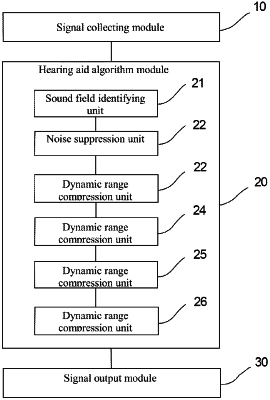| CPC H04R 25/505 (2013.01) [H04R 1/1041 (2013.01); H04R 1/1083 (2013.01); H04R 25/353 (2013.01); H04R 25/554 (2013.01); H04R 2225/41 (2013.01); H04R 2225/43 (2013.01); H04R 2430/01 (2013.01)] | 4 Claims |

|
1. A hearing aid function realization method based on a wearable device system, comprising:
collecting external sound signals based on a microphone on a wearable device, and inputting the collected external sound signals into pre-installed hearing aid software;
processing the external sound signals based on the hearing aid software to obtain the processed sound signals, wherein the processed sound signals meet the hearing aid needs of hearing-impaired users;
transmitting the processed sound signals to a Bluetooth headset connected with a Bluetooth module based on the Bluetooth module, so that the hearing-impaired users receive and listen to the processed sound signals based on the Bluetooth headset;
wherein the hearing aid software comprises a hearing aid algorithm module which processes the external sound signals based on the hearing aid software to obtain the processed sound signals, comprising:
identifying a sound field based on the external sound signals, determining a sound field environment corresponding to the external sound signals, and determining an algorithm processing flow corresponding to the sound field environment to process the external sound signals based on the algorithm processing flow;
conducting real-time noise estimation processing and hierarchical noise suppression processing for the external sound signals through the identifying process of the sound field to improve the signal-to-noise ratio and intelligibility of the external sound signals;
conducting dynamic range compression processing for the external sound signals after real-time noise estimation processing and hierarchical noise suppression processing so that a sound frequency band corresponding to the external sound signals meets the hearing threshold range of the hearing-impaired users;
conducting spectrum shifting processing for the external sound signals after dynamic range compression processing to transfer high-frequency sound signals in the external sound signals to intermediate and low frequency regions;
conducting feedback suppression processing for the external sound signals after spectrum shifting processing for conducting wave trapping processing for detected howling frequency points to eliminate howl;
conducting gain amplification processing for the external sound signals after feedback suppression processing according to a set gain target to obtain the processed sound signals;
the method further comprises:
manufacturing the hearing aid algorithm module into a software application program in advance, and installing the software application program in a wearable device system;
starting and closing the hearing aid software based on the use needs of the users, or for the hearing-impaired users, if the hearing aid software is used for the first time and user registration is completed in the hearing aid software, making the hearing aid software always in an operating state;
establishing a unique and independent communication channel between the microphone and the hearing aid software, automatically acquiring a permission to access the microphone by the hearing aid software when installed, and making the microphone always in the operating state to ensure that the microphone and the hearing aid software are operated synchronously;
identifying a sound field based on the external sound signals, determining a sound field environment corresponding to the external sound signals, and determining an algorithm processing flow corresponding to the sound field environment comprises:
classifying the sound field environments in advance, and setting sound field characteristics corresponding to each sound field environment, wherein the sound field environments reflect the environments of the external sound signals at this time;
conducting analogue-to-digital conversion for the external sound signals to obtain digital sound signals;
extracting the sound field characteristics from the digital sound signals, and determining the sound field environments corresponding to the sound field characteristics according to the sound field characteristics;
reading a preset algorithm library based on the sound field environments, and determining algorithm processing flows corresponding to the sound field environments, wherein a plurality of sound field environments and algorithm processing flows matched with the sound field environments are set in the algorithm library; wherein the algorithm processing flows comprise a noise suppression processing flow, a dynamic range compression processing flow, a spectrum shifting processing flow, a feedback suppression processing flow and a gain amplification processing flow; installing a selection button on the hearing aid software to select the processing flow of a spectrum shifting unit to enable the hearing-impaired users to select the processing flow as required; registering user information when the hearing aid software is used for the first time, and during registration, automatically detecting, by the hearing aid software, the degree of hearing loss of the user based on hearing information inputted by the user, and automatically opening or closing the processing flow of the spectrum shifting unit based on the degree of hearing loss;
conducting dynamic range compression processing for the external sound signals after real-time noise estimation processing and hierarchical noise suppression processing so that a sound frequency band corresponding to the external sound signals meets the hearing threshold range of the hearing-impaired users comprises:
acquiring the frequency band information of the external sound signals after real-time noise estimation processing and hierarchical noise suppression processing;
limiting the maximum output power by compression so that the sound frequency band corresponding to the external sound signals meets the hearing threshold range of the hearing-impaired users.
|